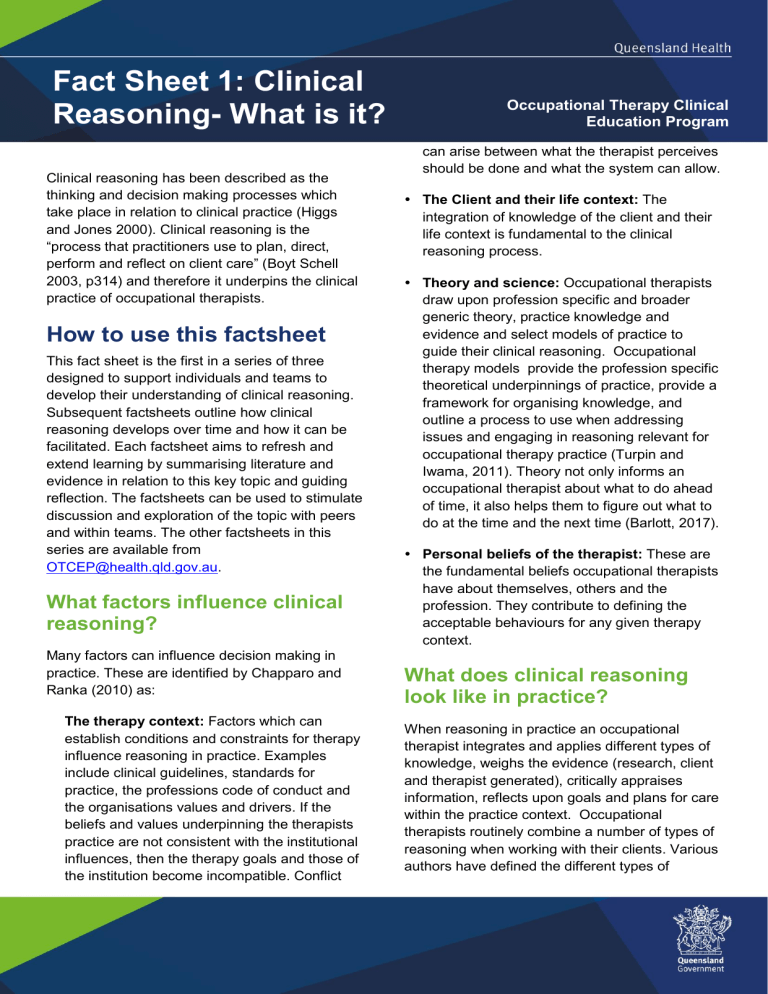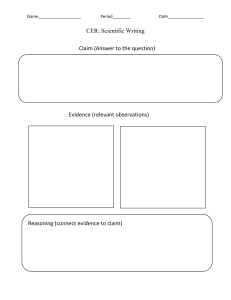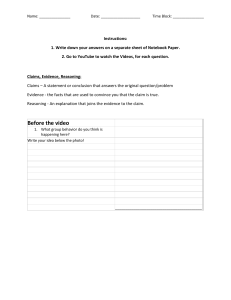
Fact Sheet 1: Clinical Reasoning- What is it? Clinical reasoning has been described as the thinking and decision making processes which take place in relation to clinical practice (Higgs and Jones 2000). Clinical reasoning is the “process that practitioners use to plan, direct, perform and reflect on client care” (Boyt Schell 2003, p314) and therefore it underpins the clinical practice of occupational therapists. How to use this factsheet This fact sheet is the first in a series of three designed to support individuals and teams to develop their understanding of clinical reasoning. Subsequent factsheets outline how clinical reasoning develops over time and how it can be facilitated. Each factsheet aims to refresh and extend learning by summarising literature and evidence in relation to this key topic and guiding reflection. The factsheets can be used to stimulate discussion and exploration of the topic with peers and within teams. The other factsheets in this series are available from OTCEP@health.qld.gov.au. What factors influence clinical reasoning? Many factors can influence decision making in practice. These are identified by Chapparo and Ranka (2010) as: The therapy context: Factors which can establish conditions and constraints for therapy influence reasoning in practice. Examples include clinical guidelines, standards for practice, the professions code of conduct and the organisations values and drivers. If the beliefs and values underpinning the therapists practice are not consistent with the institutional influences, then the therapy goals and those of the institution become incompatible. Conflict Occupational Therapy Clinical Education Program can arise between what the therapist perceives should be done and what the system can allow. The Client and their life context: The integration of knowledge of the client and their life context is fundamental to the clinical reasoning process. Theory and science: Occupational therapists draw upon profession specific and broader generic theory, practice knowledge and evidence and select models of practice to guide their clinical reasoning. Occupational therapy models provide the profession specific theoretical underpinnings of practice, provide a framework for organising knowledge, and outline a process to use when addressing issues and engaging in reasoning relevant for occupational therapy practice (Turpin and Iwama, 2011). Theory not only informs an occupational therapist about what to do ahead of time, it also helps them to figure out what to do at the time and the next time (Barlott, 2017). Personal beliefs of the therapist: These are the fundamental beliefs occupational therapists have about themselves, others and the profession. They contribute to defining the acceptable behaviours for any given therapy context. What does clinical reasoning look like in practice? When reasoning in practice an occupational therapist integrates and applies different types of knowledge, weighs the evidence (research, client and therapist generated), critically appraises information, reflects upon goals and plans for care within the practice context. Occupational therapists routinely combine a number of types of reasoning when working with their clients. Various authors have defined the different types of reasoning used by occupational therapists. The types published as outcomes of a research project by Mattingly and Fleming (1994) are referred to in this fact sheet. Practice examples are given below in relation to some of their findings: When an occupational therapist uses the medical chart to collect information about the client’s diagnosis and their likely prognosis, they are using procedural reasoning. Occupational therapists commonly conduct an initial interview which offers the client opportunity to share their experiences related to their occupational performance. This approach is an element of narrative reasoning as the client’s story unfolds. When setting realistic goals with the client, the occupational therapist may need to consider a likely future for the client and the events that would shape that future. This process is an element of conditional reasoning. When working with the client to consider options for returning to their home, environmental factors and support from family or services needs to be considered using pragmatic reasoning. The ability to engage the client is central to the success of occupational therapy. Interactive reasoning enables this collaboration to occur. Reflective Questions 1. What guides your decision making in practice? 2. What impact does the therapy context have on the decisions you make in your practice? 3. Do you use a particular occupational therapy model to inform your clinical reasoning? 4. Can you think of examples of procedural, narrative and conditional reasoning in relation to your practice with current or past clients? OTCEP Fact Sheet: Clinical Reasoning1- what is it? March 2017 Would you like to explore clinical reasoning in practice further? Watch a presentation by Professor Matthew Molineux, Griffith Occupational Therapy program on Occupational Therapy Professional Reasoning: https://www.youtube.com/watch?v=h1oZvfpSOe0 References Barlott (2017) ‘Enhancing practice with theory’ presentation to OTCEP, 23rd March 2017. Boyt Schell, B.,A. (2003). Professional Thinking. In Belsedell Crepeau, E., Cohn, E.,S. and Boyt Schell, B.,A. Willard and Spackmans Occupational Therapy (314-326). Sydney: Wolters Kluwer Lippincott Williams and Wilkins. Donaghy M E and Morss K (2000) Guided Reflection: A framework to facilitate and assess reflective practice within the discipline of physiotherapy. Physiotherapy Theory and Practice 16, 3-14. Higgs J. & Jones M. (2000) Clinical Reasoning in the Health Professionals. Butterworth Heinemann, Melbourne. Mattingly, C & Fleming, M. (1994) Clinical reasoning : forms of inquiry in a therapeutic practice. Philadelphia : F.A. Davis. Turpin, MJ & Iwama, MK 2011, Using occupational therapy models in practice: A fieldguide, Churchill Livingstone, Edinburgh. Developed by: The Occupational Therapy Clinical Education Program (OTCEP): Striving for continuous improvement in access to, and the quality of clinical education for pre entry students and new graduates within Health and Hospital Services across the state. © State of Queensland (Queensland Health) 2018 http://creativecommons.org/licenses/by-nc-nd/3.0/au/deed.en For more information contact: Program Manager, OT Clinical Education Program, email OTCEP@health.qld.gov.au. An electronic version of this document is available at https://qheps.health.qld.gov.au/occupationaltherapy/education/otcep/index -2-


